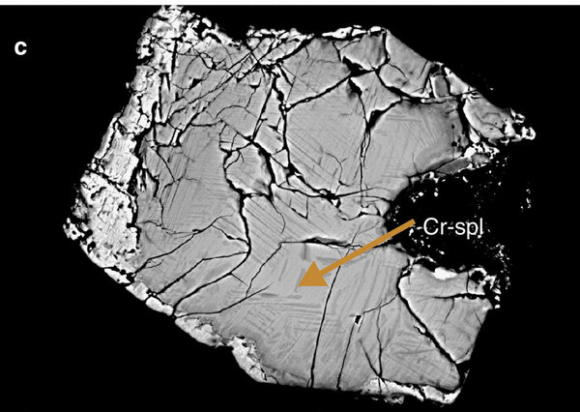470 million years ago, somewhere in our Solar System, there was an enormous collision between two asteroids. We know this because of the rain of meteorites that struck Earth at that time. But inside that rain of meteorites, which were all of the same type, there is a mystery: an oddball, different from the rest. And that oddball could tell us something about how rocks from space can change ecosystems, and allow species to thrive.
This oddball meteorite has a name: Osterplana 65. It's a fossilized meteorite, and it was found in a limestone quarry in Sweden. Osterplana 65 fell to Earth some 470 mya, during the
Ordovician period
, and sank to the bottom of the ocean. There, it became sequestered in a bed of limestone, itself created by the sea-life of the time.
The Ordovician period is marked by a couple thing: a flourishing of life similar to the
Cambrian
period that preceded it, and a shower of meteors called the Ordovician meteor event. There is ample evidence of the Ordovician meteor event in the form of meteorites, and they all conform to similar chemistry and structure. So it's long been understood that they all came from the same parent body.
The collision that caused this rain of meteorites had to have two components, two parent bodies, and Osterplana 65 is evidence that one of these parent bodies was different. In fact, Ost 65 represents a so far unknown type of meteorite.
[caption id="attachment_129450" align="alignnone" width="580"]
The faint grey lines in this electron image of Ost 65 are called "shock deformation lamellae" and they are evidence that Ost 65 was the result of a collision. Image: B. Schmidt[/caption]
The
study
that reported this finding was published in Nature on June 14 2016. As the text of the study says, "Although single random meteorites are possible, one has to consider that Öst 65 represents on the order of one per cent of the meteorites that have been found on the mid-Ordovician sea floor. "It goes on to say, "...Öst 65 may represent one of the dominant types of meteorites arriving on Earth 470 Myr ago."
The discovery of a type of meteorite falling on Earth 470 mya, and no longer falling in our times, is important for a couple reasons. The asteroid that produced it is probably no longer around, and there is no other source for meteorites like Ost 65 today.
The fossil record of a type of meteorite no longer in existence may help us unravel the story of our Solar System. The
asteroid belt
itself is an ongoing evolution of collision and destruction. It seems reasonable that some types of asteroids that were present in the earlier Solar System are no longer present, and Ost 65 provides evidence that that is true, in at least one case.
Ost 65 shows us that the diversity in the population of meteorites was greater in the past than it is today. And Ost 65 only takes us back 470 mya. Was the population even more diverse even longer ago?
The Earth is largely a conglomeration of space rocks, and we know that there are no remnants of these Earthly building blocks in our collections of meteorites today. What Ost 65 helps prove is that the nature of space rock has changed over time, and the types of rock that came together to form Earth are no longer present in space.
[embed]
Ost 65 was found in amongst about 100 other meteorites, which were all of the same type. It was found in the garbage dump part of the quarry. It's presence is a blemish on the floor tiles that are cut at the quarry. Study co-author Birgen Schmitz told the BBC in an interview that "It used to be that they threw away the floor tiles that had ugly black dots in them. The very first fossil meteorite we found was in one of their dumps."
According to Schmitz, he and his colleagues have asked the quarry to keep an eye out for these types of defects in rocks, in case more of them are fossilized meteorites.
Finding more fossilized meteorites could help answer another question that goes along with the discovery of Ost 65. Did the types and amounts of space rock falling to Earth at different times help shape the evolution of life on Earth? If Ost 65 was a dominant type of meteorite falling to Earth 470 mya, what effect did it have? There appear to be a confounding number of variables that have to be aligned in order for life to appear and flourish. A shower of minerals from space at the right time could very well be one of them.
Whether that question ever gets answered is anybody's guess at this point. But Ost 65 does tell us one thing for certain. As the text of the study says, "Apparently there is potential to reconstruct important aspects of solar-system history by looking down in Earth's sediments, in addition to looking up at the skies."
 Universe Today
Universe Today

